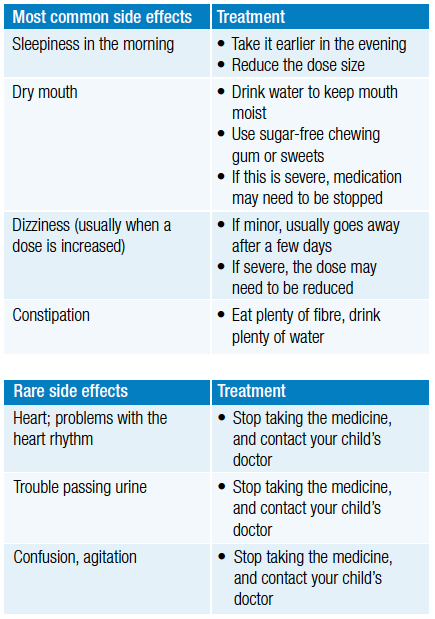Amitriptyline (children)
What is it?
Amitriptyline (brand name: Endep) is a medicine that is used to help manage chronic (long term) pain. It is often recommended in particular when people have been having a lot of trouble sleeping due to the impact of the pain. It is also used in higher doses to treat depression.
How will it help?
When pain has been present for some time (e.g. more than a few weeks), the nerves in the area can become sensitised. This is when nerves start to send pain signals more often and more easily, meaning your child may start to feel more pain in the area. Things that are usually okay, like shaking hands, may become painful.
How is amitriptyline given?
Amitriptyline is available as tablets.
What is the dose, and how often is it given?
The dose depends on the size and weight of your child. It also depends on how well the amitriptyline works for them. It is usually started at a low dose, which is then increased. This is done for two reasons: to reduce the possibility of side effects, and to find the lowest dose necessary. Amitriptyline makes your child feel sleepy. It is given at night, so that your child can get to sleep more easily. It should be taken about 30 minutes before bed-time, although some people need to take it earlier.
How long will it be used for?
Amitriptyline is often used as a “cycle breaker” in pain conditions. This means that it will be used for a few months to try to alter how the pain nerves are working. The dose will then be reduced or ceased. If the pain becomes a problem again, amitriptyline can be restarted. Some young people are on amitriptyline for several years.
Are there any side effects?
Side effects are more likely to occur at higher doses.

Things you need to know when taking this medicine
Amitriptyline can be stopped straight away if necessary. It is not addictive, and your child doesn’t become dependent on it. Within the first few days it will help your child get to sleep more easily. Amitriptyline is not a pain killer, even though it is used to help pain. It reduces the nerve sensitivity over time. You will start to notice that your child can do things that would have been too painful before. It might take several weeks before seeing this benefit. Please keep this medicine stored away from small children. Amitriptyline can be dangerous in cases of deliberate or accidental overdose.
What to do if my child is sick
Your child can keep taking amitriptyline if they have any normal childhood illness (for example the common cold).
Interactions
Amitriptyline can interact with certain medicines: in particular, amitriptyline should not be taken with other antidepressants or tramadol. This can make your child feel unwell.
Immunisations
All vaccinations are safe to have while your child is taking amitriptyline.
Infections
There is no change or increase in the risk of infections.
Myths and misconceptions
At high doses amitriptyline can be used as an anti-depressant. People with severe depression who start on antidepressants can have an increased risk of suicide. This doesn’t happen if the person is being treated for pain, and doesn’t have depression. You may hear a lot of different information about amitriptyline from friends, pharmacists or people that you know. If you are worried about anything, please talk to your doctor or nurse.
This medicine can help with long-term pain. Keep it in a safe place, as accidental overdose can be serious.
For more information see the Amitriptyline (Paediatric) Information sheet
This Information Sheet has been prepared using materials obtained from various sources which have been reviewed by the Australian Rheumatology Association (ARA). It contains general information only and does not contain a complete or definitive statement of all possible uses, actions, precautions, side effects or interactions of the medicines referenced. This information is not intended as medical advice for individual conditions nor for making an individual assessment of the risks and benefits of taking a particular medicine. Decisions regarding the assessment and treatment of patients are the sole responsibility of the treating medical professional, exercising their own clinical judgment and taking into account all of the circumstances and the medical history of the individual patient. ARA has used all reasonable endeavours to ensure the information on which this Information Sheet is based is accurate and up to date. However, the ARA accepts no responsibility or liability for the accuracy, currency, reliability and/or completeness of the information contained in this Information Sheet. To the maximum extent permitted by law, the ARA expressly disclaims any liability for any injury, loss, harm or damage arising from or in connection with use of and reliance on the information contained in this Information Sheet. This information sheet is copyright and may be reproduced in its entirety but may not be altered without prior written permission from the ARA.Page updated April 2024Discover more...
-
What is accessible design?
Find out about what accessible design is and about the Accessible Design Division.
-
10 steps for living well with arthritis
Here is our 10 steps checklist to help you live with arthritis.
-
Children and arthritis
Arthritis can happen at any age. Here, you can find management and treatment information specifically created for the more than 6,000 Australian children living with...
Sign up to Arthritis Insights
Regular updates, news and research findings delivered to your inbox: